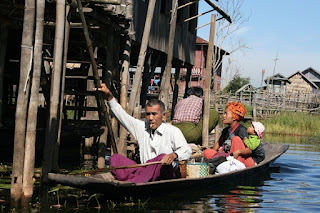By now we were used to arriving in new places in the small hours of the morning. However, we arrived in Nwangswhe on the edge of Inle Lake at 4.30am finding that our first choices for guesthouses were all fully booked. We wandered around the town bleary-eyed trying to find an alternative but to no avail. Luckily we bumped into a very nice man who was a chef at the premier hotel in town. He said that his hotel had rooms, but was a bit pricey. However, he knew another place nearby which was cheaper and we followed him on his way to work (he’d overslept and was running late to make breakfast, perhaps he needed the Bagan noise truck). He showed us to some bungalows where we were told to come back at 8am when there might be a vacancy.
We went to a tea shop to warm up with a pot of tea and some samosas. The owners were Buddhists and had the TV playing the Buddhist Channel, which one of the waiters briefly flicked to another channel to check the European football scores. We probably drank about three flasks of tea we were so cold by this point. Eventually we checked into our bungalow and slept for a few hours to catch up on sleep and warm up. It seemed we were destined to have the traditional Xmas colds after all.

After visiting the town (by daylight this time) we had an early night as we were due up early the next morning to take a boat trip around the lake. We stopped at a market, a ‘floating’ village, a silk weaving factory, a cigar factory, an umbrella factory, a pagoda and a floating tomato garden. On the way back to Nwangshwe we moored up the boat to catch the sunset when some fishermen came to us on their boats. They gave us a demonstration of their unusual rowing technique (holding the oars with their feet) and how their equally strange fishing nets worked. This was followed by a rather comical display in which one of the fishermen pirouetted on the end of his boat waving his net in the air. This resembled something like a gymnastic ballet dance.
The next day we hired a bicycle and rode around some of the lakeside villages and the sugar cane fields. We stopped when we saw a Frenchman we had met at dinner the previous night helping out a family in their caramel factory. He’d rode past and decided to help them with their operation for a bit of fun. We saw the process from sugar cane to block of caramel and we were treated to a few bars of caramel as a gift. We offered to pay for them but the family refused to accept any money. They were delicious but very sweet, so after scoffing the first bar we decided to hold the rest back to enjoy them in moderation. We rode back to Nuangshwe where we relaxed with a strawberry lassi on the lawn overlooking the river, waiting for our pickup for our bus back to Yangon. We had time to chat to our host, who was a very nice lady who told us about the troubles she has to balance her books using 3 different currencies. She has to pay some taxes using Foreign Exchange Certificates (FECs), some more taxes and a mortgage in US dollars and then finally buy everything she needs in Kyat. We also talked about politics and Myanmar government. She gave us some old and new bank notes as a souvenir with the face of General Aung San on it (Aung San Suu Kyi's father).
We knew the bus was going to be cold once the sun went down and the aircon was pumped up again, so we dressed up in more layers to prepare ourselves for the long journey. We arrived back in Yangon the following morning (again very early), and we were lucky that our hotel let us check in early and get a brief snooze. They also gave us breakfast a day early as our flight back to Bangkok was early the following morning. We spent our final afternoon in Burma strolling around Yangon, trying all the deep fried things we hadn’t tried previously and savouring the warmer temperature which was such a relief. We made our flight to Bangkok the next morning thanks to our taxi driver who somehow had managed to master the art of overtaking despite not being able to see around the car in front of him. We arrived at Yangon International in plenty of time for our flight, and we were back in Bangkok by mid-morning.

















































